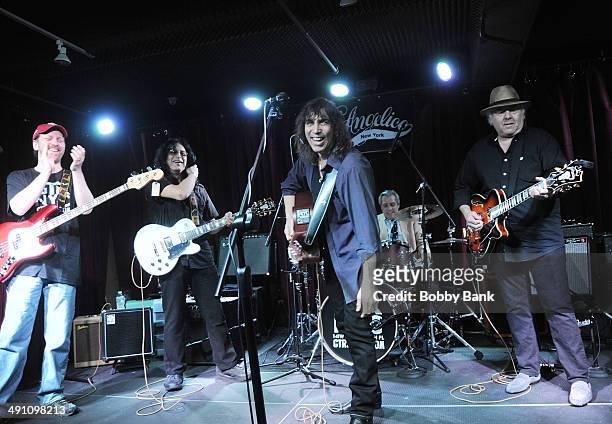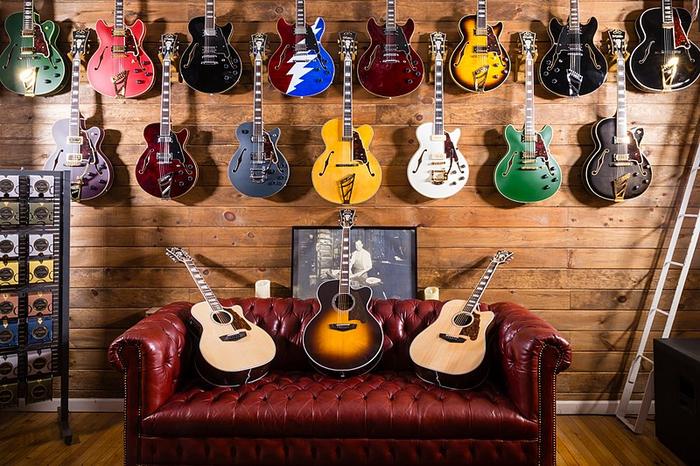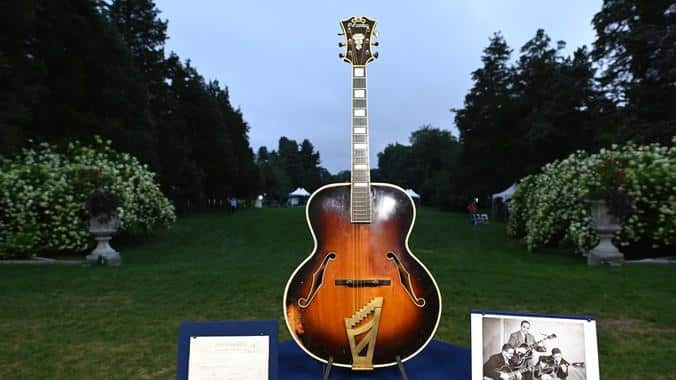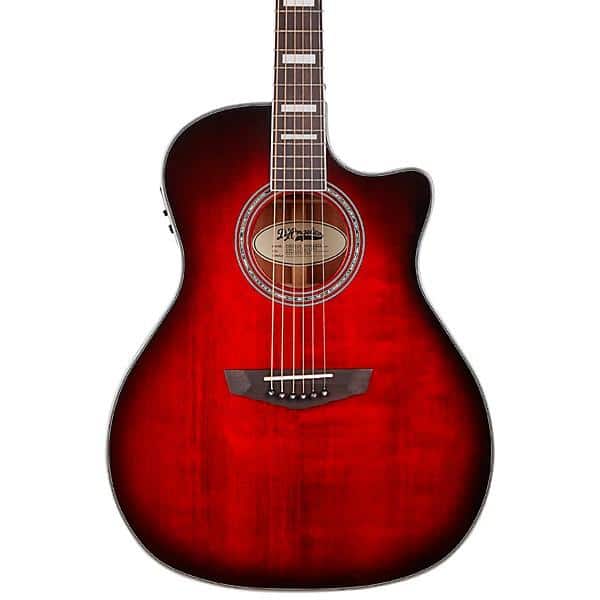The moment I strummed the strings of my first D’Angelico guitar, a sharp realization hit – not all guitars are created equal. This is Robert Williams, here to take you on a journey through the intricate craftsmanship of D’Angelico Guitars, one of the world’s most respected guitar brands. Rooted deep in tradition, yet marvelously innovative in design, these guitars are a representation of the genius of one man – master luthier John D’Angelico.
As a passionate musician who’s worked with an array of guitar brands, D’Angelico guitars stand out for their exceptional quality and distinctive design. Step into any high-profile concert or a local music session, and you’re likely to witness a D’Angelico guitar in the arms of a seasoned performer. Why? The answer lies not just in the legacy of the brand, but in the remarkable degree of devotion and skill poured into creating each guitar.
In this comprehensive review, we will peel back the layers of the D’Angelico story. Starting from a humble guitar shop in Little Italy, New York, we’ll trace the brand’s evolution, scrutinize its reputation, and explore aspects that make a D’Angelico not just a musical instrument, but a work of art. Whether you’re a seasoned guitarist or a beginner, a collector or a casual enthusiast, this exploration into the world of D’Angelico guitars will leave you with new appreciation for the extraordinary craftsmanship resonating from each strum.
D’Angelico’s History and Reputation
The Evolution of D’Angelico

As a historian and musician, I hold deep admiration for the legacy of D’Angelico. The development of this guitar-making powerhouse tells a compelling tale. D’Angelico started in the early twentieth century when Italian immigrant John D’Angelico began making archtop guitars in New York City. His masterpieces were handcrafted, using traditional methods that elevated their worth both in playability and aesthetics. D’Angelico’s history reflects its innovative approaches and enduring craftsmanship.
The Evolution of D’Angelico
From the 1930s to the 1960s, D’Angelico’s focus remained largely on archtops, earning a legendary status amongst jazz musicians. However, following John’s demise, his brand disappeared before it was reborn in the 1990s, shifting focus to a broader range of instruments. The transition from being exclusively a jazz guitar specialist to expanding its line to incorporate solid body and acoustic models signifies an important development in D’Angelico’s history.
This divergence reflects today’s modern D’Angelico instruments, encompassing an array of designs for a wider audience. It demonstrates adaptiveness without compromising on the impressive craftsmanship that marked its inception. Such evolution not only upholds the spirit of D’Angelico but also enhances its reputation by appealing to a broader demographic of guitar enthusiasts.
From a cherished instrument among jazz pioneers to a brand ardently sought after by today’s guitarists, D’Angelico’s evolution has been characterized by continuous reinvention while preserving a unyielding dedication to quality, efficiency, and a distinctive style. Each modern D’Angelico instrument pays tribute to its historical roots, infused with contemporary sensibilities that poise the brand for a future filled with endless possibilities.
As we move into dissecting the elements of D’Angelico’s reputation in the guitar world, it’s essential to remember this journey, reflecting the ingenuity and resilience that has carried this esteemed brand through the ages.
D’Angelico’s Reputation in the Guitar World

Delving deeper into D’Angelico’s reputation, it undeniably stands amid legacy guitar brands that have left indelible marks on the guitar scene. The sheer volume of positive guitar reviews and discussions on guitar forums testify to this. I can affirm that their striking blend of artistic aesthetics and acoustic mastery has served as the gold standard, influencing successive generations of luthiers.
In my extensive involvement with the guitar community, it amazes me to witness the profound respect for D’Angelico. One striking proof of this lies in the legion of famous guitarists who have chosen D’Angelico, from jazz greats like Chet Atkins and Bucky Pizzarelli to contemporary artists like Grateful Dead’s Bob Weir.
Indeed, unquestionable quality combined with a touch of artistic individuality has positioned D’Angelico as a cherished treasure in the guitar world. However, what truly amplifies their prestige is their unwavering commitment to preserving their founder’s legacy amidst the dynamics of modern guitar manufacturing. I often spend time diving into their numerous patents and unique blueprints that dutifully echo the genius of their founder, John D’Angelico — a testament to their respect for their roots.
This transition from a small workshop in Little Italy to a globally recognized brand, while maintaining their founding ethos, inherently adds to their reputation. Each instrument they produce resonates with their rich history and the passion of their craft — a harmony that truly sets them apart.
Transitioning to our next focus, it’s impossible to discuss D’Angelico without highlighting the impeccable craftsmanship that forms the backbone of their reputation. Stay with me to explore the intricate details that perennially position D’Angelico at the pinnacle of guitar making.
The Craftsmanship of D’Angelico Guitars
Hand-Made Quality

Transitioning from the rich history and evolution of D’Angelico’s brand, let’s delve deeper into the tangible essence of what sets these guitars apart: the hand-made quality. As someone who has truly felt the difference a master luthier’s hand can make, I can undoubtedly affirm the unique superiority imbued in hand-made D’Angelico guitars.
At the heart of D’Angelico’s beauty lies the meticulous handcrafting by expert luthiers. Irreplaceable are the precision, passion, and years of accumulated expertise a human touch brings to the table, surpassing any mass-produced instrument. Imagine the careful selection of tone woods, the delicate hand-carving of the top and back, and the accurate setting in of the neck—it all contributes to the overall character and identity of each individual instrument, something a machine simply cannot achieve.
Throughout the steps of creating these stunning musical masterpieces, the luthiers’ careful attention to detail is illustriously evident. From the painstaking accuracy in creating the intricate inlays to the attention paid to ensuring the components’ perfect alignment, the devotion to creating a luxurious instrument perfect in form and function, inside out, is what I believe truly encapsulates the essence of guitar craftsmanship.
To behold, touch, and play a hand-made D’Angelico guitar is to experience a labor of love that results in unrivaled resonance, sustain, and overall tonal quality. These guitars breathe life into music, giving it just the unique personality it requires. The hand-made quality therefore not only amplifies the beauty and performance of the guitar but also solidifies D’Angelico’s sterling reputation in the guitar world.
As we move onward to explore distinctive design elements, remember this: D’Angelico’s craftsmanship is not just about building guitars—it’s about creating hand-made artifacts that stand the test of time and make a statement. Each guitar speaks of the love, care, and dedication that went into its making, echoing the brand’s legacy in every note it produces.
Distinctive Design Elements

Moving into the heart of our exploration, the distinctive design elements of D’Angelico guitars are the hallmark of their uniqueness, and something I’ve always found particularly fascinating. Elaborated with an evident dedication to detail and commitment to quality, these guitars possess a radiant artistic identity that reverberates in their aesthetics as well as performance.
Guitar design is such a significant aspect of D’Angelico’s craftsmanship. It’s not just about physical allure, but how that aesthetic charm facilitates superior sound production. Their archtop guitars, for example, with their bold, curved tops, give the instruments a rich, resonant sound. With D’Angelico, every design element plays a part in fulfilling both our sensory delights and sonic expectations.
The signature stairstep tailpiece, a symbol of D’Angelico guitars, is more than a stylish emblem. It provides a break angle that improves sustain and volume. This innovative approach embodies D’Angelico‘s characteristic blend of form and function, resulting in a creative coherence I greatly admire.
D’Angelico incorporates premium guitar components, contributing to the unmatched performance these guitars deliver. The use of premium woods like spruce, maple, and rosewood in their construction enhances sound quality enormously. Specialized pickups are used across their models for distinctly clear and defined tones, and Grover Super Rotomatic tuners allow high precision tuning stability. Again, every component combines aesthetics and function, elevating the guitars to exceptional standards.
My passion for the meticulous details in D’Angelico’s design process is not simply because of the splendid appearance and superior sound these elements cater to. It’s the knowledge that every fragment of the guitar has been considered, intentionally chosen, and skillfully incorporated, reflecting a dedication to the artistry of guitar-making.
As we delve further into the differing models of D’Angelico guitars, you’ll see how these particular design elements further manifest themselves and contribute to making each D’Angelico guitar a celebrated icon.
Analyzing D’Angelico Guitar Models
Archtop and Hollow Body Models

As someone passionately drawn to the beauty of archtop and hollow body guitars, my craft has allowed me to explore many models, among which D’Angelico’s Deluxe and Excel series present strong contenders. D’Angelico’s archtop models, in particular, are an epitome of guitar craftsmanship that has stood the test of time. An elegant synthesis of creative design and precise engineering; they embody the integrity of traditional workmanship.
Deluxe series models excel in sheer aesthetics and sonic versatility. Their gracefully sculpted archtop renders a bold, clear tone, making them a perfect fit for jazz and blues enthusiasts. The hollow body structure, on the other hand, imparts a classic resonance ideal for those wanting to experiment with their sound further.
When examining the Excel series, one cannot overlook the evolutionary craftsmanship. These guitars are built with high-grade laminated spruce and maple, contributing to their distinct tonal warmth and excellent projection. Exceptionally lightweight, the Excel series models are a joy to play and hold an enduring appeal for guitarists of various genres.
Each D’Angelico model demonstrates the mastery behind the iconic brand’s reputation. My personal affinity is rooted in their unyielding commitment to maintaining the profound resonance and delicacy of the archtop tradition, while constantly innovating. The seamless combination of stellar aesthetics, thoughtful design, and superior tonal quality renders D’Angelico guitars an undeniable choice for the discerning guitarist.
As we navigate this voyage of exploring D’Angelico’s guitar models and their unique features, we are drawn closer to appreciating the brand’s contributions to evolving the guitar craftsmanship landscape.
Acoustic and Semi-Hollow Models

Having delved into D’Angelico’s archtop and hollow body creations, a deeper examination of their acoustic and semi-hollow guitars is essential. With my acoustic playing background, I’ve become quite discerning about the tonal subtleties across different guitar models. So, let’s move on to arguably the heart and soul of D’Angelico’s craftsmanship – their acoustic and semi-hollow models.
Acoustic guitars from D’Angelico blend traditional craftsmanship with modern techniques in a harmonious symphony. From the renowned Premier series guitars to other distinct models, each piece exhibits meticulous detailing and rich, balanced sound. An acoustic guitar is not just about generating sound, it’s about creating an experience. And D’Angelico’s acoustic range undeniably achieves this.
Moving on to D’Angelico’s semi-hollow guitars, they embody an incredible fusion of the resonant properties of hollow body guitars and the feedback control of solid body instruments. These guitars hit that perfect sweet spot, bringing forth a whole new dimension of sound. The semi-hollow units deliver towards both ends – impressive sustain and warm, airy resonance, establishing them as versatile tools for any guitarist.
It’s evident that acoustic and semi-hollow guitars play a crucial role in D’Angelico’s legacy and reputation. With an acute understanding of tone and technique, these models portray the brand’s commitment to quality and innovation. The acoustic and semi-hollow models bring enriching experiences to players, showcasing the best of D’Angelico’s craftsmanship. Next, let’s turn our attention to D’Angelico’s renowned, inherent qualities – its build quality, playability, and tone – further solidifying the brand’s place in the guitar world.
Quality, Playability, and Tone

In my career as a musician, I have encountered various guitars, each with its unique attributes. When analyzing D’Angelico guitar models, a critical area of focus is the trinity of guitar playability, guitar tone quality, and overall build quality. Their impact on choosing a guitar cannot be underestimated, owing to their direct influence on the instrument’s performance.
Quality in a D’Angelico guitar spins the narrative of excellent craftsmanship, embodying tonal balance and refined aesthetics. From the well-aligned fretwork to beautifully polished finishes, the meticulous attention to detail is a hallmark of D’Angelico’s reputation. It furthers a physical and visual connection between the player and the instrument.
With guitar playability, these models are designed for comfort and ease of play. The guitar neck profile, action, and string spacing all contribute to a player-friendly feel, sustaining long playing sessions with ease—a testament to the brand’s dedication to player-centric design.
Another influential area is guitar tone quality. The unmistakable D’Angelico tone is warm and articulate, satisfying the varied demands in diverse music genres. Accomplished by using high-quality tonewoods and well-crafted resonant cavities, the guitars’ voice carry a rich musicality that enhances performance.
To conclude, D’Angelico guitar models gracefully intertwine quality, playability, and tone, constituting a fulfilling musical experience. As we stride forward in our exploration, let this appreciation of these factors form the basis of our understanding of the value and collectability of D’Angelico guitars.
Value and Collectability

As a vintage guitar enthusiast and collector myself, let me unwrap for you the unique allure of D’Angelico guitars, their enduring value, and the intense desire they ignite in collectors worldwide. Through my personal journey of collecting high-end guitars, I’ve experienced the unparalleled craftsmanship, tone, and artistry that D’Angelico embodies. This chapter will explore their enduring appeal and why they hold a revered place among guitar collectibles.
Let’s address an intriguing question – What makes some D’Angelico guitars ‘collectibles’ in the guitar world? The answer stems from a powerful blend of historical significance, extremely limited production numbers, supreme craftsmanship, and distinctive aesthetics. These ingredients, taken together, confer an enduring desirability and value to vintage D’Angelico guitars that exceed many counterparts in the market.
The unique status of D’Angelico guitars originates in their earliest days. When John D’Angelico started crafting his instruments in the 1930s, he was creating limited number of handmade masterpieces, each one special in its own right. This relative scarcity only amplifies their allure to guitar enthusiasts and collectors today. When one of these historical gems comes up for sale, it’s a noteworthy event that sends ripples through the guitar world.
Nestled in the collector’s heart, the obsession for D’Angelico guitars is not solely driven by rarity. These instruments are renowned for their unrivaled craftsmanship. The meticulous attention to detail, the expertly sculpted curves, the hand-picked tonewoods that render each note with rich warmth and clarity – each element is a testament to John D’Angelico’s mastery and passion. It’s this heritage that endows every D’Angelico guitar with an authentic soul and voice.
Finally, the iconic design elements unmatched by any other brand captivate the discerning eyes of collectors. From the signature headstock designs to the exquisitely crafted neck inlays, D’Angelico guitars are instantly distinguishable. Thus, each guitar serves as both an instrument for musical expression and a stunning work of art.
When these distinctive characteristics combine, we witness not merely a guitar, but a cherished collectible – an irreplaceable part of music history. The sheer excitement and profound sense of pride in owning a D’Angelico guitar are unparalleled. Similarly, the potential for financial appreciation is considerable for certain vintage models, further amplifying their allure for collectors.
As we venture into the next chapter, we will delve deeper into specific models throughout D’Angelico’s history, exploring their unique features, and the irreplaceable spot they hold in the pantheon of guitar collectibles. Prepare to uncover the magic that is D’Angelico – a true testament to the art of guitar-making.
FAQs
What are D’Angelico Guitars best known for?
What expertise is involved in crafting D’Angelico Guitars?
Who uses D’Angelico Guitars?
What is unique about the design of D’Angelico Guitars?
Conclusion
In summing up my exploration of D’Angelico Guitars, a legacy guitar brand that has played a substantial role in the history and development of the guitar world, I’ve gained a profound respect for their remarkableness. Their longevity is testament to a never-compromising ethos of craftsmanship, quality and tone, heartily recognized by seasoned and modern guitarists alike.
Each D’Angelico guitar is a symphony of distinctive design elements, intricate craftsmanship, and unparalleled tonal quality, whether it’s their legendary archtop designs or the contemporary semi-hollow and acoustic models. As someone who has immersed themselves fully in the world of guitars, the commitment to a hand-made, quality-first approach that D’Angelico’s team sustains is deeply inspiring.
Collectors, musicians, or anyone passionate about guitars can propound on the value of a D’Angelico. It’s more than just a musical instrument; it’s a piece of art, a tangible reflection of a paramount legacy. More than just the coherency of my words, I want aspiring guitarists to experience the resounding music of a D’Angelico, the product of a brand’s rich history and, above all, a deeply personal labor of love. As we move forward, remember the D’Angelico name stands not just for a guitar, but for an enduring legacy of uncompromising craftsmanship.